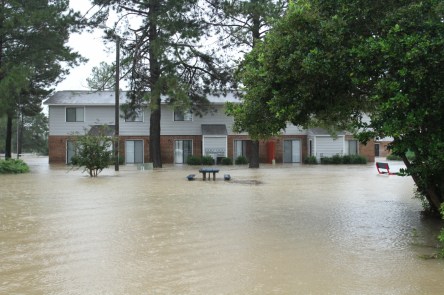For many residents, the Great Flood feels like it was only yesterday. In October 2015, the state of South Carolina received record-breaking precipitation. More than 25 inches of rain fell across the coastal region in less than 20 hours. Additional water spilled into the devastated communities when 13 dams failed. Homes flooded, ousting residents into the streets or crowded shelters. Businesses closed, adding to the economic strain of the struggling region. Even 74 miles of I-95, a major thoroughfare for relief and supplies, became impassible. “Our state was devastated,” recalls Babbie Jaco, vice president of Boyd Management, a Yardi client. “Meadowfield Apartments, a USDA 515/Section 8 property in Summerton, SC–a very poor area–had more than 40 inches of water. There was water up to the windowsills for weeks. The water just wouldn’t recede.” The deluge of water saturated the soil and overwhelmed runoff infrastructure. To make matter worse, a ply board and other debris prevented a local storm drain from functioning. Local authorities would not discover the root of the problem until the DOT ditch had become a small lake. As the water lingered for weeks, residents of Meadowfield Apartments could not return home. Local Boy Scouts hosted a temporary camp for the residents. Yet as the fall pressed onward, the 150 displaced residents needed a place to call home. A Community United Many residents of the community, including the property owners, did not have flood insurance. As the property fell further into disrepair, with repair costs estimated to be more than $1.4 million, HUD prepared to remove its subsidy. News of the displaced families spread throughout the region. Then the volunteers arrived. Community members provided the manpower to clear the site and prepare it for renovation. Summerton Baptist Church joined forces with Southern Baptist Disaster...
Finally, Good News
For Affordable Housing
After several years of reporting housing shortages and funding restrictions, there is a break in the clouds for affordable and Low-Income Housing Tax Credit (LIHTC) housing. The respite could not have come at a better time, other than sooner. The National Low-Income Housing Coalition recently released its 2016 report. The nation faces a shortage of 7.2 million affordable housing and available rental units. That means that there are only 31 affordable and available rental units for every 100 eligible households. Of those that can find housing, one in four spend more than 50 percent of their monthly income on rent. Those figures only partially influence the increase in available funding for the sector. Borrowers are now seeing an increase as banks loosen their purse strings to honor Community Reinvestment Act requirements. In 2015, Fannie Mae reported a total lending volume of $42.3 billion for affordable projects. Changes in product offerings are partially responsible for the increase in competitive loans. One new product is the Reduced Occupancy Affordable Rehab (ROAR). ROAR allows Frannie Mae to extend financing for qualified affordable housing properties in need of renovations, eliminating the need for a construction loan. Across the U.S., newfound funding is helping some companies expand their services. Affordable Housing News reports that the National Development Council Corporate Equity Fund (NDC CEF), for example, has raised $70 million for its fully specified Fund XII. The organization can now expand its products to include investment and low-income communities. With the funding, NCD CEF launched 12 LIHTC projects. The projects will include affordable housing for families, the elderly, those with special needs, and residents who require consistent assistance. The good news continues as Congress re-examines the cap on LIHTC. According to an article in Affordable Housing Finance, Sen. Maria Cantwell...


